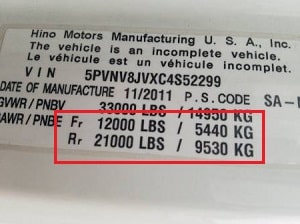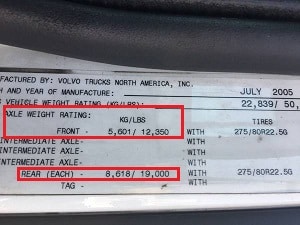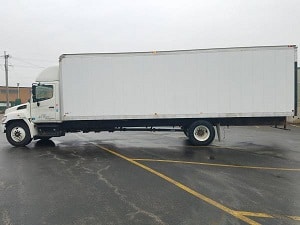 There is a big difference between a Class A and Class B cdl (Commercial Driver’s License). In this article I’m going to explain what the differences are using easy to understand explanations and pictures.
There is a big difference between a Class A and Class B cdl (Commercial Driver’s License). In this article I’m going to explain what the differences are using easy to understand explanations and pictures.
Before you even decide to pursue a cdl you need to know which one you need.
First, determine which kind of commercial vehicle you will be driving. After you figure out which kind of commercial vehicle you are going to drive this article will help you figure out which is the correct cdl class for you.
If you are going to get a cdl it is strongly recommended you get a Class A cdl because it opens up your driving career to a world of options.
A Class A cdl allows you to drive any type of commercial vehicle out there.
In this article I will explain the differences between a Class A, Class B, and Class C cdl and what you can drive with each one
What Is A Class A CDL?
A class A cdl is considered the universal commercial driver’s license because with it you are able to drive any (almost any) Class A, Class B, or Class C commercial vehicle with it.
There are some exceptions though. For example, if you want to drive a hazmat vehicle or a school bus you will also have to get the necessary endorsements.
The Class A cdl is the one to get if you want to drive an 18 wheeler/semi truck. If you know for sure that you are going to drive a semi truck then there is no need to look at any other cdl. The Class A is the one for you.
The technical answer: A Class A cdl is required to operate any combination of vehicles with a gross weight rating of 26,001 or more pounds (11,794 kg) including a towed vehicle with a gross weight of 10,000lbs (4,546kg) or greater.
Explained: So what does this mean? Let me explain. If the manufacturer weight rating of the vehicle (often called the tractor) is 26,001 lbs or more and the manufacture weight rating of the towed vehicle (often called the trailer) is over 10,000 lbs you will need a Class A commercial driver’s license.
Okay, so what does “manufacturer weight rating” mean? The manufacturer weight rating is not the actual weight of the vehicle.
It is the amount of weight the axles can support. For example, if a vehicle has a manufacturer weight rating of 29,000 lbs this simply means that the total weight of the vehicle and everything on/in it can be up to 29,000 lbs.
The vehicle cannot exceed a total weight of 29,000 lbs. Remember, the total weight includes the weight of the vehicle as well as passengers, cargo, and/or loads.
Example 1: Take a regular passenger car for example. The front axle of the car may have a weight rating of 1,500 lbs and a rear axle weight rating of 2,000 lbs.
This means that the car is approved by the manufacturer to carry a total load (car, passengers, and cargo/load) of 3,500 lbs.
You would not be able to drive a car around with 27,000 lbs of stuff on it because the car is not rated to transport stuff that has a weight of 27,000 lbs or more.
If you drove a car that had more than 27,000 lbs of stuff on it and were stopped by a police officer you would be cited.
Example 2: Take a look at the tractor below and the manufacturer weight ratings of the vehicle. The front axle of the tractor is rated to 12,350 lbs and the tow rear axles are rated at 38,000 lbs (19,000 lbs each). The weight of the tractor and the load that it is carrying (includes passengers) cannot exceed 50,350 lbs.


What You Can Drive With A Class A CDL
There are a bunch of commercial vehicles you can drive with a Class A cdl. Among them are the following:
Tractor Trailers: also known as semi trucks or 18 wheelers. The truck most people think of when they think of truck drivers.
Tractor and Trailer Combinations (double and triple trailers): these are tractors that have more than one trailer.
Tanker Vehicles: these are used to transport liquid loads or gases.
Livestock Carriers: livestock carriers are used to transport livestock like pigs and cows.
Flatbeds: flatbeds are trailers that are not enclosed.
All Class A and Class B commercial vehicles below can also be driven with a Class A cdl. (note: endorsements may be required for some Class B and Class C vehicles)
What Is A Class B CDL?
The technical answer: The Class B cdl allows you to drive a single vehicle that has a gross vehicle weight rating of 26,001 lbs or more and is pulling a trailer that has a gross vehicle weight rating of less than 10,000 lbs.
Explained: Remember, we are talking about manufacturer weight ratings of the axles, not actual weight of the vehicle. If the vehicle has a manufacturer rating of over 26,001 lbs. (meaning the vehicle can carry a total weight of 26,001 lbs. or more) and the towed vehicle rating is less than 10,001 lbs. you will need a Class B cdl.
The Class B cdl is not for tractor trailers, it is usually for single framed vehicles only.
If you are wondering whether or not every box truck requires a cdl I think you will be surprised after reading this article I recently wrote.
An example: The box truck pictures below (not pulling a trailer with a gross vehicle weight rating of over 10,001 lbs) that is used to make deliveries has a gross vehicle weight rating of 33,000 lbs will need a Class B cdl. The front axle has a gross weight rating of 12,000 lbs and the rear axle has a weight rating of 21,000 lbs.
The gross vehicle weight rating is 33,000 lbs and a Class B cdl is required.
If a trailer that had a gross weight rating of less than 10,000 lbs was attached to the box truck it would still only require a Class B cdl. Once the weight rating of the trailer exceeds 10,001 lbs a Class A cdl is needed.


One important thing to note is that with a Class B cdl you are allowed to drive Class B and Class C commercial vehicles but not Class A commercial vehicles.
Note: some additional endorsements may be needed in order to drive some vehicles with your Class B cdl.
The biggest difference between the Class B and Class A cdl is that the class B is for towing vehicles that have a weight rating of no more than 10,001 lbs.
If the trailer being towed has a gross weight rating of 10,001 lbs or more you need a Class A cdl.
What You Can Drive With A Class B CDL
With a Class B cdl you cannot drive tractor trailers/semi trucks, you are usually limited to full frame trucks only.
What is a full frame truck? Well, they are also called cube trucks, box truck, and straight trucks.
Here are some commercial vehicles that you are allowed to drive with the Class B cdl:
Straight trucks: these are vehicles which carry cargo in a body mounted to its chassis, rather than on a trailer being towed. Something that will surprise you is that those box trucks you see driving around don’t all require a cdl. I wrote all about box trucks in this article that is worth reading.
Large Passenger Buses: (city buses, tourist buses, and school buses) Segmented Buses
Garbage Truck
Box trucks for delivery drivers: box trucks are trucks with a cube shaped cargo area.
Dump trucks with small trailers: the trailer must have a gross weight rating of less than 10,000 lbs.
Cement Mixer
Food Truck: only if the food truck has a weight rating of 26,001 or more lbs. Not all of them do.
What Is A Class C Cdl?
A Class C cdl is basically used for commercial vehicles that the Class A and Class B cdl doesn’t cover but is designed to transport 16 or more passengers and has a gross vehicle weight rating of less than 26,000 lbs.
What You Can Drive With A Class C CDL
Passenger Vans/Shuttle Buses
Small Hazmat vehicles
Small combination vehicles: something like a small truck towing a trailer
Which CDL Class Should You Get?
If you are entering truck driving and are unsure of which class cdl you should get you are not alone.
This is a common question potential drivers face. A strong piece of advice I have for you is to pursue a Class A cdl because with it you can drive just about any Class B and Class C commercial vehicle.
Getting a Class A cdl opens up your career options a lot. By having the Class A cdl you have so many more job opportunities available to you.
Some of you may be 100% sure that you only need a Class B cdl because you are going to driving a box truck. This is a huge misconception.
Guess what? You don’t even need a cdl at all to drive a box truck. In this article I explain exactly why you don’t need one.
Just make sure that you are aware that some box trucks do require a Class B cdl.
However, ask any driver with several years experience and they will tell you to always get the Class A because life changes.
You might be okay driving a box truck now but what about if you need more money to support a family by driving a tractor trailer? Guess what you need to drive a tractor trailer? That’s right, a Class A cdl.
Life changes, the job you have in the next few years might not be the best one for you in 10-15 years. Prepare yourself now so that you have a chance to progress in the commercial vehicle driving profession.
Trust me, if you are going through cdl training/school you might as well go for the Class A cdl. It’s the smart thing to do.
Do You Need A CDL To Drive A Garbage Truck?
A Class B cdl is usually the minimum that you will need in order to drive a garbage truck. Make sure you check with your specific state though.
Most companies will require you to have a Class B or a Class A cdl to drive for them.
To make yourself more appealing to possible employers it is strongly recommended you get your Class A cdl so that you are legally able to drive just about any commercial vehicle.
Do You Need A CDL To Drive A Cement Truck?
In order to drive a cement truck you will also need to have a Class B CDL. Again, getting your Class A CDL is the best thing to do for your career because it allows you to drive Class A, B, and C, commercial vehicles. If you ever make a change and decide to drive something else you are going to be covered with a Class A.
Do You Need A CDL To Drive A Food Truck?
The Class B cdl the one you need if you are going to be driving a food truck. If you know that you will never be driving a tractor trailer you don’t need to pursue a Class A.
Call around at your local CDL schools and community colleges and ask them if they offer cdl training for Class B only. These courses are typically short and can be completed in 10-14 days.
Do You Need A CDL To Drive A Moving Truck Like A UHaul?
No. You don’t need a cdl to drive a Uhaul style moving truck.
Their trucks are not considered commercial vehicles which means a cdl is not needed. Trust me, there are a lot of people not comfortable with someone that is not trained to drive a commercial vehicle driving some of those big trucks.
How do they get away with it? None or their vehicles are weight rated to have a total weight of 26,001 lbs. or more.
To see some picture of box trucks that do not require a cdl I strongly recommend you check out this article that I recently wrote.
Do You Need A CDL To Drive An RV?
You usually don’t need a cdl to drive an RV. If the RV has a weight rating of less than 26,000 lbs. then you don’t need to have a cdl. The only time you would need a cdl to drive one is if it has a manufacture weight rating of 26,001 lbs or more, but it is rare that an RV would have a weight rating this high.
I wish the answer to this question was simple, it’s not. Each state is a little different and what is okay in one state may not be in another.
I do always recommend you contact your local DMV just to make sure that you don’t need to have a cdl because some states that don’t require a cdl do require some type of testing.
Do You Need A CDL To Drive A Dump Truck?
Yes, you will need at least a Class A cdl. Most companies that will hire you are going to be looking for a Class A or B.
Do You Need A CDL To Pull A Trailer?
You only need to have a cdl if the vehicle towing has a manufacturer weight rating of 26,001 lbs or more. If the vehicle is rated to to carry over 26,0001 lbs or more then you will need a cdl, regardless of the weight rating of the trailer.
For example, if you are pulling a trailer with your Ford F150 and each axle has a weight rating of 5,000 lbs you don’t need a cdl because your F150 is not rated to carry 26,001 lbs. or more. It is rated to carry 10,000 lbs.
I do suggest you check with your local DMV just to make sure that you are driving within your state laws. Also, if your trailer or load you are carrying has a weight rating over 10,000 lbs you need to check with you state laws.